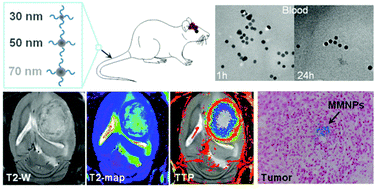Passive targeting of high-grade gliomas via the EPR effect: a closed path for metallic nanoparticles?†
Abstract
Passive tumor targeting via the enhanced permeability and retention (EPR) effect has long been considered the most effective mechanism for the accumulation of nanoparticles inside solid tumors. However, several studies have demonstrated that the EPR effect is largely dependent on the tumor type and location. Particularly complex is the situation in brain tumors, where the presence of the blood–brain tumor barrier (BBTB) adds an extra limiting factor in reaching the tumor interstitium. However, it remains unclear whether these restraints imposed by the BBTB prevent the EPR effect from acting as an efficient tumor targeting mechanism for metallic nanoparticles. In this work, we have studied the EPR effect of metallic magnetic nanoparticles (MMNPs) in a glioblastoma (GBM) model by parametric MRI. Our results showed that only MMNPs ≤50 nm could reach the tumor interstitium, whereas larger MMNPs were unable to cross the BBTB. Furthermore, even for MMNPs around 30–50 nm, the amount of them found within the tumor was scarce and restricted to the vicinity of large tumor vessels, indicating that the BBTB strongly limits the passive accumulation of metallic nanoparticles in brain tumors. Therefore, active targeting becomes the most reasonable strategy to target metallic nanoparticles to GBMs.



 Please wait while we load your content...
Please wait while we load your content...